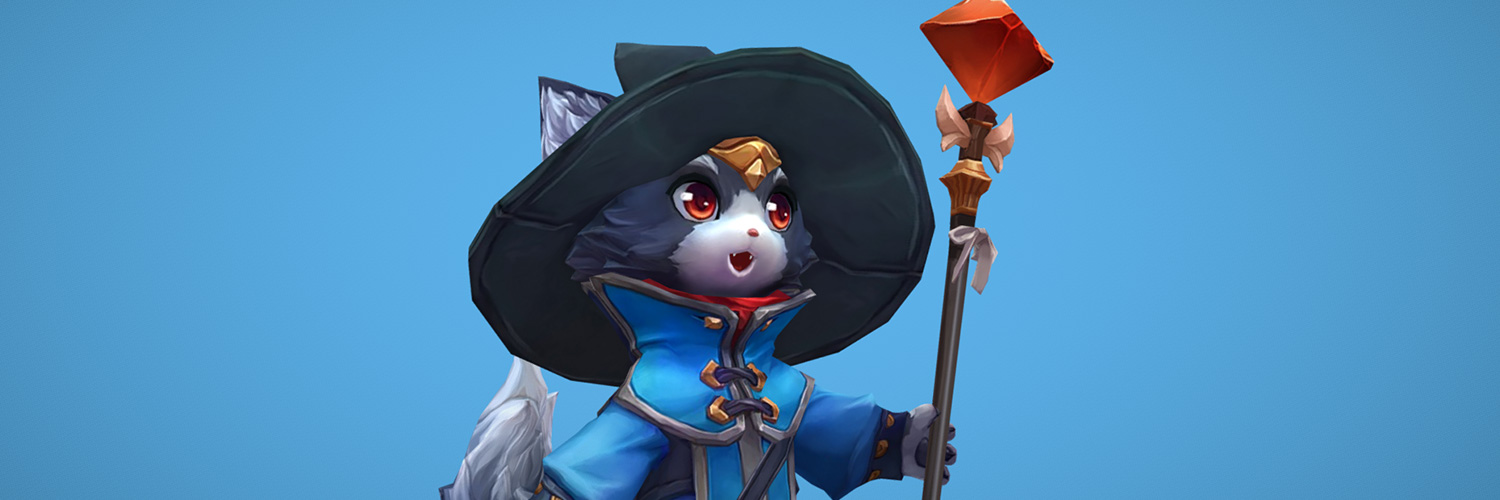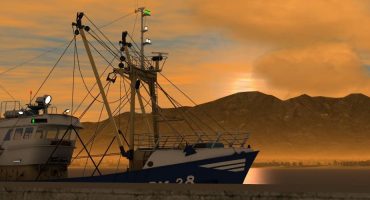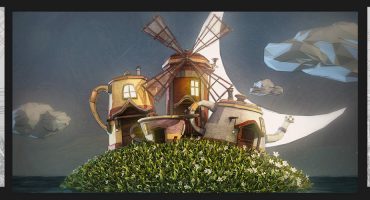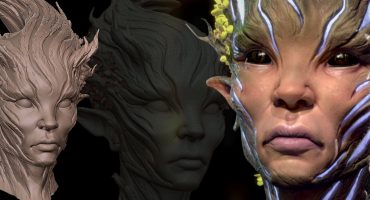In Art Spotlight, we invite Sketchfab artists to talk about one of their designs.
Hi guys!
My name is Maria Panfilova. I’m a 3d character artist from Russia.
In this article I will show you how I made the Wizard Cat. I’m going to share with you some of techniques I use. I made it using ZBrush, Maya, Substance Painter, 3DCoat and Photoshop.
Regarding the handpainted textures, there are two ways to work: starting from lowpoly and painting all the volume and details from scratch
starting from a highpoly model and then baking it to lowpoly
I prefer the second way because for me it’s more predictable and the result is very close to what I see inZBrush. And it’s fun! I can’t miss an opportunity to sculpt more! It seems to me that more and more artists today prefer creating hand painted models from a highpoly sculpt.
First of all I want to reccommend some tutorials I found useful for me.
- Marc Brunet – 3D Hand-painted Character For Games
- Ryan Ribot – Stylized Creature Texturing. Very interesting techniques
They both use Maya, ZBrush, 3D-Coat and Photoshop.
So let’s start with my project.
Inspiration
I can’t say how much I admire Ryota Murayama`s works. All of his shapes are pure cuteness! I wanted to soak in his beauty as much as I could and create a similar character style. So I collected a huge amount of references with this style. Not only of animals, but also RPG human characters.
When I create personal work I spend a lot of time studying references and returning to them over and over. I find this critical to improving the level of my work. When you see how people use form and choose colors, you start to do the same intuitively.
Let me give an example. When I’m modeling a cat paw, I’m not just doing it from memory, or from photo references, but I also check out how other artists stylize cat paws.
And the same process covers all parts of the character.
Design
What I had in mind was to make a party of three characters – Archer, Mage and a heavily armored guy. And I wanted them all to be standing in some epic pose facing danger :)
What animals could they be? For Archer, it should be something sneaky like a fox or racoon. For the heavily armored guy, it should be something big like a bear, and for Mage… well, cats are magical creatures :)
So this is my first sketch of three of them:
The key thing when you making a concept in ZBrush is not to worry about tools, but be familiar with them because your mind must be free from anything else but the design of the character. If you are not familiar with ZBrush tools yet, I would recommend that you make 2D concepts first or practice with other people’s concepts. It’s very valuable for improving your skill too!
When you are concepting, don’t forget to switch to flat shader to check the silhouette. It’s like a flipping canvas in photoshop – it helps to refresh your mind and see the overall look.
Later I realised that making 3 characters at once is too big a task for my schedule, and I chose one to continue.
For stylistic modeling I recommend that you try Orb’s brushes. I love them. Especially the Orb crack brush. I use it everywhere.
I made colors in ZBrush too – we can use them later. Flat colors will be more useful than detailed polypainting but you can do both. Flat color will be used as an ID mask. Polypainting can be used as a texture base.
There are a lot of sources on the internet that can help you find the right colors for your project. Some of them that I would recommend are Dota 2 Character Art Guide and Marc Brunet’s tutorial. Of course color is a deep subject and requires a lot of study and practice.
Everytime I wanted to stick to a specific color scheme that I chose beforehand, it was a failure. So the best decisions that I make are more intuitive. But eitherway, I always try to find out whether the colors combine with each other and determine how much of each color to use.
For coloring, I make autogroups and turn on “mask by polygroups” (in the brush pallete at the picture below) so I can paint meshes separate from each other. Very handy. If you want just to fill meshes with color you can also set focal shift to -100 (hard brush) and turn off pressure sensitivity in the brush palette.
In fact, you don’t need to make a very clean sculpt. The most critical thing is the overall silhouette because you will make a lowpoly from it. But all other inaccuracies can be fixed by painting. So the more you sculpt, the more information you provide in your future map, but you can paint all these details much faster.
Anyway, I made a quite clean sculpt because I just wanted to be sure. I trust my sculpting skills more than my drawing ones.
Lowpoly
Thanks to Sketchfab, you have a great souce of references and ideas about how character’s wireframe should look. You can just turn on wireframe mode in viewer and look at it from all angles.
There’s no need to worry about polycount much when it’s a personal work. This is not an AAA game character. So about 7k tris is okay for MOBA or other games as well as for mobile games.
To make a lowpoly and bake maps later I need to decimate the model. I do a retopo in Maya.
Sometimes you may face problems if your highpoly has a lot of overlapping meshes. In this case its better to combine highpoly meshes with dynamesh and make a retopo from it.
I made the staff and book as separate objects with their own textures, which means that they are custom equipment that can be replaced in game by something else.
With lowpoly, I use classical trick for clean baking. I take objects that are overlapping and separate them into groups, and then I make a one-frame animation to separate them from each other. Of course, highpoly should be done the same way.
Baking
So why do I bake in Substance Painter? Because it has an amazing baked light filter! You can see how it works here.
You can set up how how warm or cold you want your light to be, combine it with diffuse, and work with many other additional factors like reflectance, cavities and so on. It’s very interactive – you can turn the lights off and on to see the results of the diffuse immediately. Of course, the result looks generic but it’s a good base for further painting.
All I need is highpoly with an ID mask to bake all the maps that Substance Painter provides. Then I use these maps to make fake lighting effects.
When I bake the position map I set it to One Axis to make gradients from the top to the bottom of the cat.
This is an often-used technique. It helps to attract attention to the top part of the character.
You can make a gradient not only from lighter to darker tones, but you can also make a hue gradient – from colder to warmer colors, and the opposite. Check out how gradient is used in this amazing texture by Volodya Liubchuk. From top to bottom, the paws becomes darker and more blue. The same with the tail.
I also set max Occluder distance in the ambient occlution tab to 0.6 to make AO more rich. This is all I change from the default settings when baking.
I usually make a cold light color (sky), and a warm shadow color (ground). The sun color I keep yellow but I turn down the intensity.
You can do the opposite – light is warm and shadow is cold. That would also look good.
As long as I have an ID mask, I can use different baked lighting settings for different materials. In my case, I used it for gold. The gold was set up as metallic and shiny.
So this is how my texture looked like almost without any brush strokes.
This is how my layer structure looked like in the end:
Painting
Then, I imported the result into 3D-Coat and started making a paintover. I use 3D-Coat for painting because it has very handy bridge with Photoshop. Some actions like quick color correction or detail painting I find more comfortable to do in Photoshop. I also like how I can merge layers in 3D-Coat (in Substance Painter I can’t do that yet). 3D-Coat is a simple software to learn and you don’t actually need to know a lot of tools to paint there.
I don’t like to paint on a complex layer structure so I merge them every time. To work with some materials separately I keep my ID map at the top layer and keep it invisible. When I need to select something, I turn this layer on and use select -> color range tool in Photoshop. It helps me select the area I need very fast. With this method, for example, I changed the color of cat’s book, and made a lot of other tweaks.
Painting takes time. I scroll through the references of handpainted textures and look at what other artists do. Usually I paint some addition higlights and shadows, make color diversity, fix the generic look of baked textures, and so on. I usually use a hard brush, but sometimes I switch to soft. I keep in mind that my shadow is warm and my lighting is cold, and stick to that in my overpaint.
I don’t like to put too many details like fur texture or patterns. These characters are usually simplified in games and too many details are distracting.
Pose
When the texture is close to finished, I switch to posing in ZBrush. I import my lowpoly, switch it to flat color shader and import textures. Using layers in ZBrush is very handy when you make a pose. For example you can make a smile separate from the pose and switch it on and off to experiment with how it fits with a character’s look.
Ground
So when the pose was done, I made the ground very quickly with the same process – sculpted it in ZBrush, retopo, baked all maps and overpainted.
You can see how the ground sculpt looked below:
After that, I made my last tweaks with the texture (I refreshed my mind when I did the pose and the ground) and the model was done!
Now it’s time to set up everyting in Sketchfab and upload! :)
I hope that spotlight was useful to you. Feel free to comment if you have questions.
Good luck with your own creations!
Maria.
Thanks Maria!
You can follow Maria here on Sketchfab and on ArtStation.

















